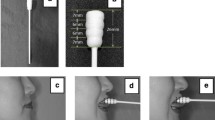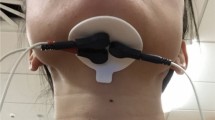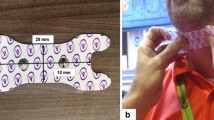Abstract
This study explored the influence of two methods of effortful swallow execution on the timing of pharyngeal pressure events. Participants were asked to either emphasize or minimize tongue-to-palate contact during performance of the maneuver. Twenty healthy participants were evaluated using concurrent submental surface electromyography (sEMG), orolingual manometry, and pharyngeal manometry. Each subject performed three repetitions of three counterbalanced tasks (noneffortful dry swallows, effortful dry swallows with tongue-to-palate emphasis, and effortful dry swallows with tongue-to-palate de-emphasis). Four variables were measured: Onset Lag vs. sEMG Peak, Peak Lag vs. sEMG Peak, Total Duration, and Percent Rise Time to Peak. Compared to noneffortful swallows, the effortful swallow task elicited significantly earlier onsets and peaks of pharyngeal pressures relative to the submental sEMG peak. Total pressure event durations were greater and rise times were significantly shorter. When comparing the two methods of effortful swallow execution, a longer latency to peak proximal pharyngeal pressure was found in the tongue-to-palate emphasis condition. These results support the interpretation that the effortful swallow maneuver involves generation of higher velocity bolus driving forces that propel the bolus into and through the pharynx with greater efficiency and that pressure is then sustained to facilitate more complete bolus clearance.


Similar content being viewed by others
References
Murry T, Carrau R, Eibling D: Epidemiology of swallowing disorders. In: Carrau R, Murry T (eds.) Comprehensive Management of Swallowing Disorders (San Diego, CA: Singular Publishing Group), 1999, pp 3–9
Huckabee ML, Pelletier CA: Management of Adult Neurogenic Dysphagia (San Diego, CA: Singular Publishing Group), 1999
Logemann JA: Evaluation and treatment of swallowing disorders, 2nd ed. (San Diego, CA: College Hill Press), 1997
Kahrilas PJ, Logemann JA, Krugler C, Flanagan E: Volitional augmentation of upper esophageal sphincter opening during swallowing. Am J Physiol 260(3 Pt 1):G450-G456, 1991
Kahrilas PJ, Logemann JA, Gibbons P: Food intake by maneuver; an extreme compensation for impaired swallowing. Dysphagia 7:155–159, 1992
Kahrilas PJ, Lin S, Logemann JA, Ergun GA, Facchini F: Deglutitive tongue action: volume accommodation and bolus propulsion. Gastroenterology 104:152–162, 1993
Bryant M: Biofeedback in the treatment of a selected dysphagia patient. Dysphagia 6:140–144, 1991
Crary MA: A direct intervention program for chronic neurogenic dysphagia secondary to brainstem stroke. Dysphagia 10:6–18, 1995
Huckabee ML, Cannito M: Outcomes of swallowing rehabilitation in chronic brainstem dysphagia: a retrospective evaluation. Dysphagia 14:93–109, 1999
Kahrilas PJ, Logemann JA: Volume accommodation during swallowing. Dysphagia 8:259–265, 1993
Hind JA, Nicosia MA, Roecker EB, Carnes ML, Robbins J: Comparison of effortful and noneffortful swallows in healthy middle- aged and older adults. Arch Phys Med Rehabil 82:1661–1665, 2001
Hiss SG, Huckabee ML: Timing of pharyngeal and upper esophageal sphincter pressures as a function of normal and effortful swallowing in young healthy adults. Dysphagia 20:149–156, 2005
Huckabee ML, Steele CM: An analysis of lingual contribution to submental sEMG measures and pharyngeal biomechanics during effortful swallow. Arch Phys Med Rehabil: in press, 2006
Bulow M, Olsson R, Ekberg O: Videomanometric analysis of supraglottic swallow, effortful swallow, and chin tuck in healthy volunteers. Dysphagia 14:67–72, 1999
Bulow M, Olsson R, Ekberg O: Videomanometric analysis of supraglottic swallow, effortful swallow, and chin tuck in patients with pharyngeal dysfunction. Dysphagia 16:190–195, 2001
Bulow M, Olsson R, Ekberg O: Supraglottic swallow, effortful swallow, and chin tuck did not alter hypopharyngeal intrabolus pressure in patients with pharyngeal dysfunction. Dysphagia 17:197–201, 2002
Olsson R, Kjellin O, Ekberg O: Videomanometric aspects of pharyngeal constrictor activity. Dysphagia 11:83–86, 1996
Salassa JR, DeVault KR, McConnel FMS: Proposed catheter standards for pharyngeal manofluorography (videomanometry). Dysphagia 13:105–110, 1998
Huckabee ML, Hiss SG, Barclay M, Jit S: The relationship between submental semg measurement and pharyngeal pressures during normal and effortful swallowing. Arch Phys Med Rehabil 86(11):2144–2149, 2005
Stevens JP: Applied multivariate statistics for the social sciences, 4th ed. (Mahwah, NJ: Lawrence Erlbaum Associates), 2002
Kotrlik JW, Williams HA: The incorporation of effect size in information technology, learning, and performance research. Infor Technol Learn Perform J 21:1–7, 2003
Levine TR, Hullett CR: Eta squared, partial eta squared, and misreporting of effect size in communication research. Hum Commun Res 28:612–625, 2002
Author information
Authors and Affiliations
Corresponding author
Additional information
Work performed at the Van der Veer Institute for Parkinson’s and Brain Research, Christchurch, New Zealand
Rights and permissions
About this article
Cite this article
Steele, C.M., Huckabee, M.L. The Influence of Orolingual Pressure on the Timing of Pharyngeal Pressure Events. Dysphagia 22, 30–36 (2007). https://doi.org/10.1007/s00455-006-9037-4
Received:
Accepted:
Published:
Issue Date:
DOI: https://doi.org/10.1007/s00455-006-9037-4




